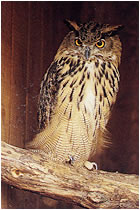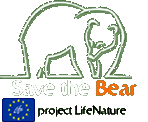
The Life Projects
for the protection of the brown Marsicanus bear
(Ursus arctosmarsicanus).
2004 saw the launch, in the Sirente Velino Regional
Nature Park, in the Abruzzo Region of Italy, of
the new “Life-Natura” Project “Save
the Bear”. The intention behind this project,
financed by the General Directorate of the Environment
of the European Commission and by the “Ente
Parco” [Park Administration Agency], is
to implement a number of specific initiatives
to conserve the small nucleus of bear to be found
within the area of the Park.
The Sirente Velino Park had already been the subject
of other Life projects over the years 1994-2001.
However, while the early projects had made it
possible:
- to determine the presence
of the bears between the Sirente Velino massifs
(during the first project in October 1996, a
3-5 year old male specimen was, unfortunately,
found dead by poisoning).
- to launch the conservation
strategy by taking action at Community Interest
Sites (C.I.S.) identified as a single system
of faunal corridors.
The aim of the project currently underway is
to stabilise conservation work so as to ensure
that plantigrades can enjoy territories which
are protected, safe as well as more suited to
their survival.
The logic behind the projects carried out in
the Sirente Velino Park – made possible,
we repeat, by the sole instrument which the European
Union makes available on
an individual basis for the numerous types
of Nature Conservation work – has always
been that of containing and reducing the impact
of human disruption and thus to lessen the direct
danger to the survival of the bear specimens,
while at the same time launching an environmental
up-grading process in the areas concerned according
to the feeding and survival requirements of the
species.
The initiatives have concentrated on:
- Identifying the faunal corridors sued by
the bear, its protection and conservation;
- Supplementing and increasing food resources,
involving work to improve habitat environments
(pruning, planting fruit trees, be-keeping and
the dissemination of honey bees);
- Reducing poaching and vandalism by introducing
appropriate and widespread surveillance and
crime prevention measures;
- Improving the relationship between human activities
and the territory, by introducing natural forestry
practices with the aim of changing excessively
artificial and overly productive woodland over
to a more natural form of distribution;
- Raising public awareness and informing local
communities, particularly school-age children,
by developing well-planned environmental education
programmes.
Natural woodland management has not hampered
the use of resources on the part of local populations,
indeed it was precisely this initiative which
constituted an extraordinary example of endeavour
to reconcile the sustainable use of natural resources
with the safeguarding of the protected species.
Over time these projects have likewise created
interesting job opportunities for local people
living in the Park. Young people, local co-operatives,
working farmers and small holders have all been
involved, in various capacities, in tree felling,
pruning, planting, bee-keeping, path repair and
maintenance and other more specialised activities
such as environmental education and nature monitoring
of the territory.
LEVEL OF AWARENESS OF THE PRESENCE OF THE MARSICANUS
BEAR IN THE SIRENTE VELINO PARK.
Monitoring work carried out using natural methods
(periodic inspections of crossing points, distinguishing
feature surveys, periodic checks on cattle carcasses
found and incidents of aggression or even by preparing
some attractive sites with honey during the autumnal
and spring-summer periods), together with field
surveys and analyses of the various environmental
variables, have made it possible to draw up various
themed maps and consequently to identify all the
sensitive areas for the survival of the bear in
the Park.
Between 1994 and 2002 a total of 78 presence signs
were collected. During the course of the last
Projects, a number of suitable hibernating sites
were found used by a few specimens.
This piece of information is itself important
because it testifies to the fact that one or more
bear specimens, of the nucleus found, could be
non-migratory and live permanently within the
Park, instead of moving from the territory of
the neighbouring Abruzzo, Lazio and Molise National
Park.
Constant monitoring of the areas has also made
it possible to pinpoint the principal factors
which determine the movement of the plantigrades
within the Park, one, two and from the heights
of the Abruzzo National Park and the Monte Genzana
Reserve, the other towards the Gran Sasso and
Monti della Laga National Park and the Monti della
Duchessa in the Lazio region.
In conclusion, the data which have emerged from
the work carried out over the last project years,
have made it possible to confirm, given its geographic
location and high environmental worth, the central
role of the Sirente Velino Park within the scope
of the distribution area of the Brown Marsicanus
bear.
The recent financing of the new project would
seem to be extremely important for the Sirente
Velino Park. The project is due to be completed
in September 2007 and has as its main objective
the reduction of the threat directed at the bears,
a threat which all too often derives from the
inconsiderate use of poisons, as a result of the
conflicts with livestock farmers in the territory.
In this case too, it is clear how conservation
work strongly touches upon the sustainable use
of the territory, the close link between human
activities and natural resources.
This is an important sign, therefore, because
while on the one hand conservation work is given
a boost, on the other the challenge is renewed
to demonstrate that an active nature protection
policy can quite rightly constitute a reliable
instrument for economic development in the protected
areas of Europe.
The Project reporte
Dr. Emilio SINIBALDI
Head of project
Arch. Oremo DI NINO
Co-odination staff:
Dr. Luigi LOGIUDICE
Dr. Paola MORINI
|
 |

